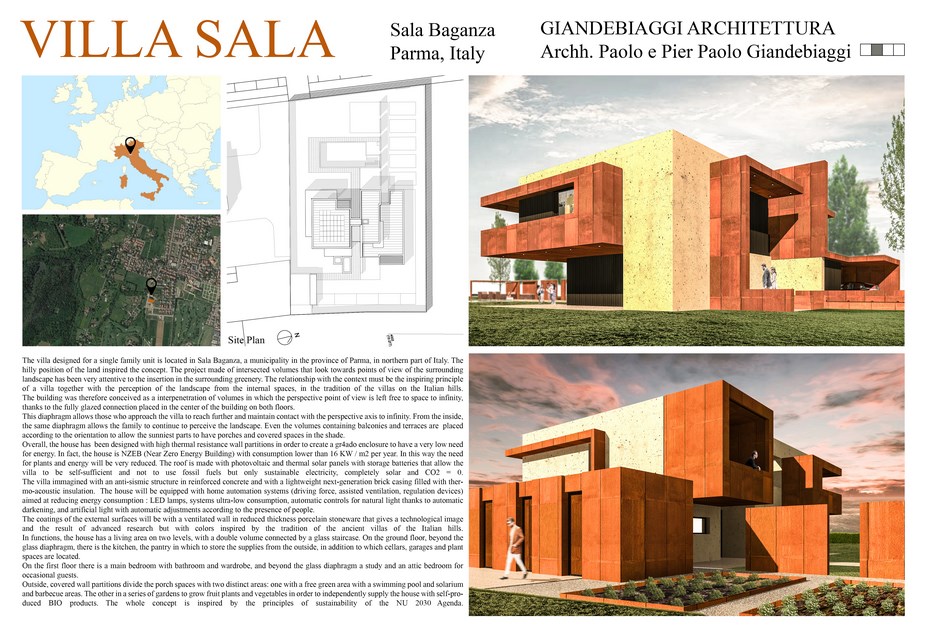Villa Sala by Giandebiaggi Architettura | World Design Awards 2020
Giandebiaggi Architettura: Honorable Mention of World Design Awards 2020. The villa designed for a single-family unit is located in Sala Baganza, a municipality in the province of Parma, in northern part of Italy. The hilly position of the land inspired the concept. The project made of intersected volumes that look towards points of view of the surrounding landscape has been very attentive to the insertion in the surrounding greenery. The relationship with the context must be the inspiring principle of a villa together with the perception of the landscape from the internal spaces, in the tradition of the villas on the Italian hills.
The building was therefore conceived as a interpenetration of volumes in which the perspective point of view is left free to space to infinity, thanks to the fully glazed connection placed in the center of the building on both floors.
This diaphragm allows those who approach the villa to reach further and maintain contact with the perspective axis to infinity. From the inside, the same diaphragm allows the family to continue to perceive the landscape. Even the volumes containing balconies and terraces are placed according to the orientation to allow the sunniest parts to have porches and covered spaces in the shade.
Overall, the house has been designed with high thermal resistance wall partitions in order to create a gr4ado enclosure to have a very low need for energy. In fact, the house is NZEB (Near Zero Energy Building) with consumption lower than 16 KW / m2 per year. In this way the need for plants and energy will be very reduced. The roof is made with photovoltaic and thermal solar panels with storage batteries that allow the villa to be self-sufficient and not to use fossil fuels but only sustainable electricity, completely solar and CO2 = 0.
The villa immagined with an anti-sismic structure in reinforced concrete and with a lightweight next-generation brick casing filled with thermo-acoustic insulation. The house will be equipped with home automation systems (driving force, assisted ventilation, regulation devices) aimed at reducing energy consumption : LED lamps, systems ultra-low consumption, automatic controls for natural light thanks to automatic darkening, and artificial light with automatic adjustments according to the presence of people.
The coatings of the external surfaces will be with a ventilated wall in reduced thickness porcelain stoneware that gives a technological image and the result of advanced research but with colors inspired by the tradition of the ancient villas of the Italian hills.
In functions, the house has a living area on two levels, with a double volume connected by a glass staircase. On the ground floor, beyond the glass diaphragm, there is the kitchen, the pantry in which to store the supplies from the outside, in addition to which cellars, garages and plant spaces are located.
On the first floor there is a main bedroom with bathroom and wardrobe, and beyond the glass diaphragm a study and an attic bedroom for occasional guests.
Outside, covered wall partitions divide the porch spaces with two distinct areas: one with a free green area with a swimming pool and solarium and barbecue areas. The other in a series of gardens to grow fruit plants and vegetables in order to independently supply the house with self-produced BIO products. The whole concept is inspired by the principles of sustainability of the NU 2030 Agenda.

Firm: Giandebiaggi Architettura
Architect: Paolo Giandebiaggi
Category: Residential Concept
Project Location: Sala Baganza – Parma
Team: Paolo Giandebiaggi, Pier Paolo Giandebiaggi
Country: Italy
Photography ©Credit: Pier Paolo Giandebiaggi
![]() Paolo Giandebiaggi, Architect and University Professor. In over 30 years of activity it has carried out more than 100 public and private interventions (www.giandebiaggi.it). He has designed numerous interventions of sustainable architecture, urban design and architectural redevelopment. Since 1988 he has been teaching at the University of Parma and the Polytechnic of Milan respectively at the Faculty of Architecture and the Faculty of Design. Since 2002 he is Ordinary Professor and coordinates the Laboratory in Restoration and Reuse of Architecture. The overall activity was the subject of books, publications and exhibitions. He is currently the representative for Italy on the European Commission’s Architecture Qualification Committee in Brussels.
Paolo Giandebiaggi, Architect and University Professor. In over 30 years of activity it has carried out more than 100 public and private interventions (www.giandebiaggi.it). He has designed numerous interventions of sustainable architecture, urban design and architectural redevelopment. Since 1988 he has been teaching at the University of Parma and the Polytechnic of Milan respectively at the Faculty of Architecture and the Faculty of Design. Since 2002 he is Ordinary Professor and coordinates the Laboratory in Restoration and Reuse of Architecture. The overall activity was the subject of books, publications and exhibitions. He is currently the representative for Italy on the European Commission’s Architecture Qualification Committee in Brussels.







